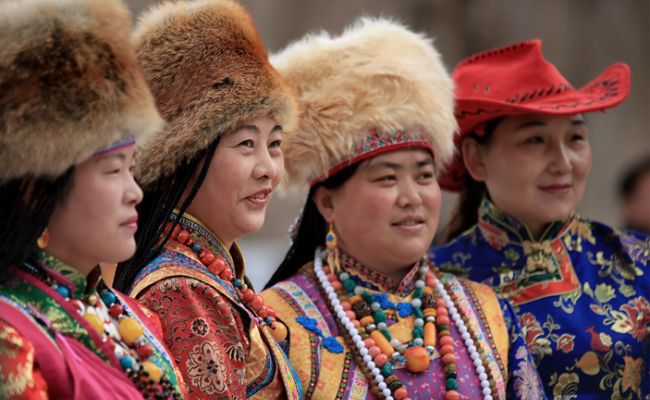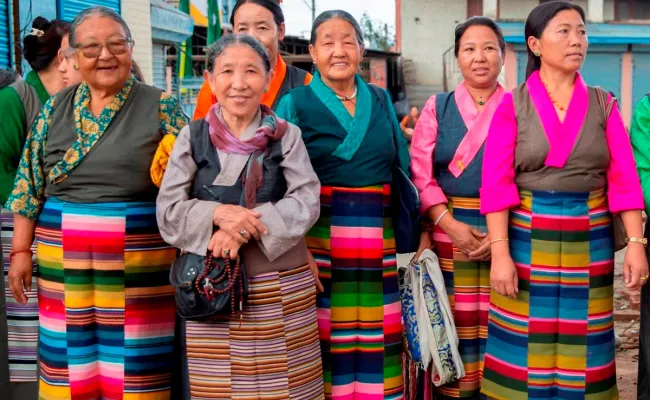Tibet is a land with ancient culture and customs that have endured to the present day. The Tibetan people place a high priority on preserving local traditions, which is part of what makes visiting Tibet so distinctive. From lifestyle and rituals to food and clothes, this is your comprehensive introduction to the Tibetan people.
What do Tibetans People look like?
Like any other group of people around the world, Tibetans are diverse, but they share some characteristics. It is usual to observe Tibetans with weathered or sun-darkened skin. This is due to the harsh weather and high levels of sunlight in the region.

In addition to the dark hair, eyes, and epicanthic folds that many Asians have, many Tibetans have prominent and high cheekbones that give their features a distinct aspect.
Tibetans also have physical features influenced by their high-altitude habitat, such as greater lung capacity and efficient oxygen usage, which allow them to survive comfortably in harsh situations.
The Rich History of Tibetan People
Tibet’s history spans thousands of years, with traces of human presence dating back to the Paleolithic epoch. The early Tibetan society was nomadic, with herding animals as its primary activity.
One of the oldest ethnic groups in China and South Asia, the Tibetan people have an inextricable connection to China’s history. The establishment of the Tubo Kingdom in the early 7th century led to an increase in relations between Tubo and the Tang Dynasty. From the tenth to the sixteenth centuries, the ancient Tibetan culture thrived.
What do Tibetan people eat?
The harsh local environment influences traditional Tibetan cuisine, emphasizing hearty and nourishing meals to deal with the cold winter and high elevations.
Tsampa and butter tea are two of the most notable examples. Tibetans produce butter tea by combining tea leaves, butter, and salt. It may be an acquired taste, but it is an important element of Tibetan culture and a tremendous source of energy and warmth when it is chilly. Tsampa is a mainstay of local cuisine. Frequently served with butter tea or yogurt, roasting barley flour and mixing it with butter tea or water gives it a softer consistency.

Other hearty and unusual native meals include momos, which are steamed or fried dumplings filled with meat, veggies, or cheese. Thukpa is a thick noodle soup that is popular throughout the colder months. They cook it with wheat or rice noodles and serve it in a delicious broth with veggies and, in some cases, meat. Social events and festivals frequently offer Chang, a classic barley beer.
Tibetan cuisine makes extensive use of yak meat and dairy products. Various recipes prepare yak meat as dumplings, soup, roast, or stew. Various dairy products also incorporate yak milk. Yak butter is an important cultural and religious ingredient in Tibetan cuisine.
What religion do Tibetans believe in?
Tibetan Buddhism plays a significant role in the cultural, social, and spiritual lives of the vast majority of Tibetans. Tibetan Buddhism is a separate form of Buddhism that emerged over centuries on the Tibetan Plateau, blending parts of Indian Buddhism with local beliefs and rituals.
Prayer flags embroidered with mantras are common sights throughout the rugged terrain as pilgrims travel to religious locations. Intricate mandala art and Thangka paintings adorn various locations, acting as instruments for meditation and spiritual reflection.
What Language Does the Tibetan People Speak?
Tibetan is the primary language of the Tibetan people, both in Tibet and in the Tibetan diaspora around the world. Classical Tibetan is the literary language used in Buddhist scriptures, religious literature, and historical documents. Modern Tibetan, on the other hand, is the spoken language used for daily communication.
Regional variations and historical factors have resulted in the formation of many Tibetan dialects spoken throughout the Tibetan Plateau and nearby regions. Amdo Tibetan, a dialect prevalent in sections of China’s Qinghai, Gansu, and Sichuan provinces, has distinct pronunciation and lexical distinctions.
Other dialects, such as Dzongkha, Bhutan’s official language, are comparable to Tibetan spoken in Lhasa but have separate grammars.
What traditional clothes do Tibetans wear?
Tibetan traditional attire reflects the region’s distinct climate, history, and cultural identity. The most recognizable garment is the chuba, a long woolen robe. Worn by both men and women, the chuba is frequently brightly colored with elaborate patterns that vary depending on location and occasion. Women also wear pangdens over their chubas. A colorful apron-like sash represents a woman’s marital status and regional identity.

Traditional dress varies by place and occasion. Women in Bhutan wear bakhu, an ankle-length woven-fabric dress. Tibetans dress in their nicest attire and jewelry for major occasions such as the Tibetan New Year, Losar, and weddings.
What are the most important Tibetan festivals?
Tibetan culture is rich with traditional celebrations that take place year-round. Losar, the Tibetan New Year, is among the most important. It occurs in February or March and lasts many days, with rituals, prayers, feasting, and cultural activities.
The event honors the birth, enlightenment, and death of Buddha, also known as the Saga. Dawa is another significant celebration. It usually takes place in May or June and is regarded as an auspicious season for religious activities like pilgrimage and charitable gestures.
August hosts Shoton, a celebration that showcases massive Thangka sacred artworks. The Yogurt Festival features opera performances, traditional dances, and yogurt eating. Cham dance festivals take place throughout the year in various monasteries and localities. Monks execute the dances, which serve as symbols for Buddhist teachings, tales, and legends.
